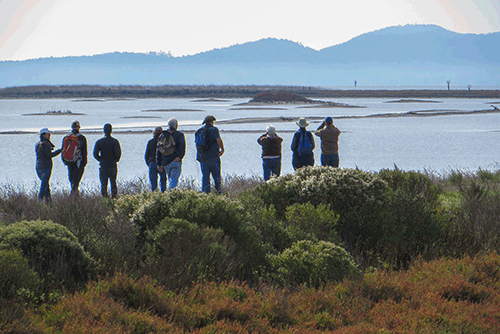报名链接
活动时间和地址
2018年2月18日,周日10:00am - 12:00am
Don Edwards San Francisco Bay National Wildlife Refuge Environmental Education Center
1751 Grand Blvd, San Jose, CA 95002
Please bring water, sunscreen, and a hat and wear clothes appropriate for hiking and gardening.
活动简介
The San Francisco Bay Bird Observatory (SFBBO) is a nonprofit in Milpitas dedicated to the conservation of birds and their habitats through science and outreach. Since 1981, we’ve been the local authority on the birds that rely on the San Francisco Bay and its surrounding environments. We envision a San Francisco Bay Area of healthy bird populations, healthy human communities, and healthy ecosystems. We believe the best way to reach that vision is to base land and resource management decisions on sound science, and we understand this can only happen with strong community support.
The Opportunity for Valley Rain Reading Club
Since 2011, our Habitats Program team has been testing strategies to help Bay Area tidal marshes adapt to sea level rise, and our research and techniques are now being used by partners around the Bay. We invite the team at Valley Rain Reading Club to participate in this effort by volunteering at our latest tidal marsh restoration site, Pond A17, located along Coyote Creek at the Don Edwards San Francisco Bay National Wildlife Refuge in Alviso.
Pond A17 was designed by the South Bay Salt Pond Restoration Project (California Coastal Conservancy) to help restore 130 acres of tidal marsh. SFBBO is growing and planting upland plant communities around the site to help marshes migrate away from rising seas more quickly and provide habitat for endangered species such as the Ridgeway’s Rail and Salt Marsh Harvest Mouse. Volunteers from Valley Rain Reading Club are invited to spend the day with us planting special species that we grew in our nurseries and tour the pond area to learn about the importance of this work. We would provide all the tools and training needed for that day.
The Value
The San Francisco Bay is home to a diverse range of plant and animal species. It nurtures fish populations and colonially-nesting waterbirds, is a significant wintering area for waterfowl, and is recognized as a site of hemispheric importance for migratory shorebirds. Its wetlands serve as important flood control buffers between Bay waters and upland territories. The surrounding riparian, grassland, and upland habitats are equally important, supporting numerous plants and animals, as well as hundreds of passerine, raptor, and other local and migratory landbird species.
The Challenge
We live and work in a rapidly changing landscape. The San Francisco Bay Area is one of the most heavily developed estuaries in the world, with nearly 8 million people living on its shores, placing unprecedented pressures on the region’s biological resources, goods, and services. Over the last 150 years, an estimated 90% of historic tidal marsh has been eliminated through development and/or conversion to salt evaporation ponds and agricultural fields. Urban development and climate change also continue to press heavily on the area’s wildlife habitats, and sea level rise and other impacts also threaten human communities.
The Solution
Maintaining and restoring a sound ecosystem that serves the needs of the people and wildlife species living in the Bay Area is a balancing act that requires a carefully-planned effort by qualified people; the application of sound science to policy and land use decision making; and community-wide commitment and support.
Our Work
For more than 35 years, SFBBO has conducted research in the Bay Area and has evolved into a leading authority in field techniques and the study of landbirds, waterbirds, and their habitats in the Bay Area. Our biologists and ecologists leverage the support of partnering organizations, student interns, and more than 100 citizen science volunteers, who help conduct our research, and we share our research findings with land use managers and policy makers, university students, fellow scientists, and the public.
In addition, we run an outreach program to educate and engage people in avian conservation and science. Each year, we offer bird walks, workshops, science talks, and special events; staff booths at community festivals and environmental fairs; engage corporations through Lunch ‘N Learn presentations, group volunteer work parties, and team building activities; and serve Bay Area families through our Family Science Night series.
Our Impact
SFBBO’s work has positively impacted native bird populations and the habitats that support them in a wide variety of ways. We have partnered with the U.S. Fish and Wildlife Service, U.S. Geological Survey, California Department of Fish and Wildlife, Midpeninsula Regional Open Space District, and many others who have used our study results to assist them in making appropriate decisions regarding land management to benefit bird populations. In addition, SFBBO’s rare, 35-plus-year datasets on waterbird and landbird communities, through partnership with academic institutions and others, have helped identify bird responses to climate change and other anthropogenic disturbances.
The public, especially SFBBO’s members and volunteers and other bird lovers, also benefit from SFBBO’s work. Through our citizen science and outreach programs, people in the community are better connected to, and supportive of, nature, and experience enhanced quality of life. Our economy is strengthened by creating a healthy environment and an informed, engaged citizenry. In addition, the sustainability of future generations is ensured when we conserve and protect our birds and other ecological resources.
For more information, please visit www.sfbbo.org or “like” our Facebook page.

Comments
comments powered by Disqus